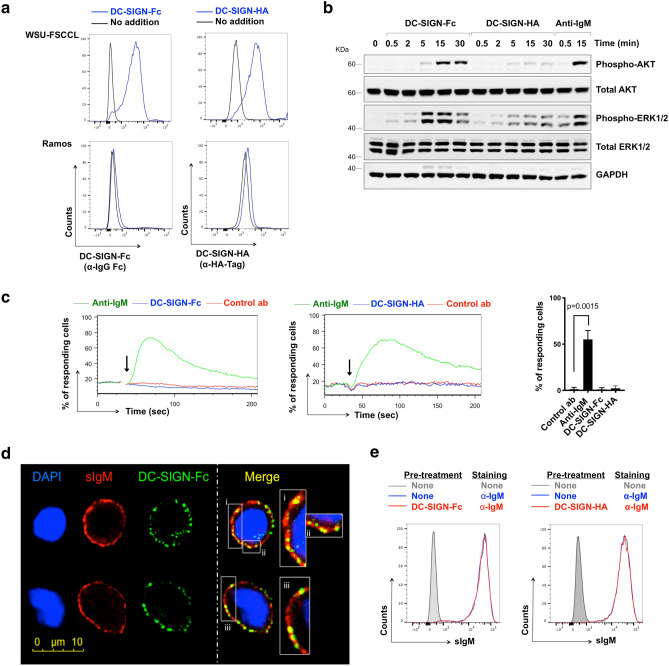Figure 3.
DC-SIGN binding and signaling in WSU-FSCCL cells. (a) Binding of DC-SIGN-Fc or DC-SIGN-HA to WSU-FSCCL and Ramos cells. Cells with no addition were analyzed as a control. Representative of 5 independent experiments. (b) WSU-FSCCL cells were incubated with DC-SIGN-Fc, DC-SIGN-HA, anti-IgM or left untreated as a control for 30 min at 4 °C and then warmed rapidly to 37 °C for the indicated times. Expression of total and phosphorylated AKT, ERK1/2 and GAPDH (loading control) was analyzed by immunoblotting. The gels were run under the same experimental conditions. Molecular weight of proteins markers shown as KDa. Results shown are representative of 3 independent experiments. Full-length blots are shown in Supplementary Fig. 3. (c) Representative iCa2+ flux analysis after addition (arrow) of anti-IgM, DC-SIGN-Fc, DC-SIGN-HA or control antibody (control ab) and summary of data for 5 separate experiments. Graph shows mean (± SD) response with values for anti-IgM-treated cells set to 100%. The statistical significance of the indicated differences is shown (paired t-test) (d) Confocal imaging of bound DC-SIGN-Fc (green) and sIgM (red) on fixed WSU-FSCCL cells. Cells were incubated with DC-SIGN-Fc at 4 °C for 1 h and anti-IgM was added for the last 30 min. DAPI staining is shown in blue. Two representative cells shown. (e) Anti-IgM accessibility with DC-SIGN bound to BCR. FACS analysis of WSU-FSCCL cells incubated with DC-SIGN-Fc (left), DC-SIGN-HA (right) or no addition for 30 min at 4 °C and stained with FITC anti-IgM or left unstained as control.

